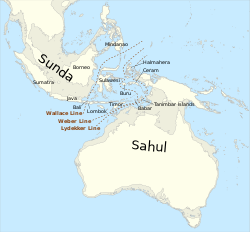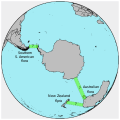Land bridge
A land bridge is a term in biogeography. It is a narrow land connection between otherwise separate areas, sometimes called an isthmus.
Its significance is that animals and plants may cross over it when the sea level is lower. They cannot easily cross when the sea level is higher, and water covers the land bridge. The separation of a once connected population often leads to speciation, the splitting of one species into two and the two species change over time to be different but have distant similarities.
Several kinds of change can cause a land bridge to rise above or sink below the water. Plate tectonics may cause the rise or lowering of land. The causes of general sea level changes are not fully understood, but often big polar ice caps lower sea level by locking up much of the water. When sea levels fall, shallow sections of continental shelf may get exposed. Sometimes the sea floor rises due to "post-glacial rebound" after an ice age.
Notable examples
- The Bering land bridge, which connected Asia with North America when the sea level dropped in the ice age, but went under water when the ice melted.
- Doggerland, a former landmass in the southern North Sea which connected the island of Great Britain to mainland Europe during the last ice age
- The Isthmus of Panama whose appearance three million years ago allowed the Great American Interchange
- Adam's Bridge (known as Rama Setu), connecting India and Sri Lanka.
Land Bridge Media
Map of Sahul and Sunda, land masses that have provided land bridges at various points throughout the Pleistocene
The botanist Joseph Dalton Hooker, noting similarities of the floras of Australia, New Zealand, and southern South America in his six-volume Flora Antarctica, published between 1844 and 1859, proposed that land bridges had once existed between these land masses.

